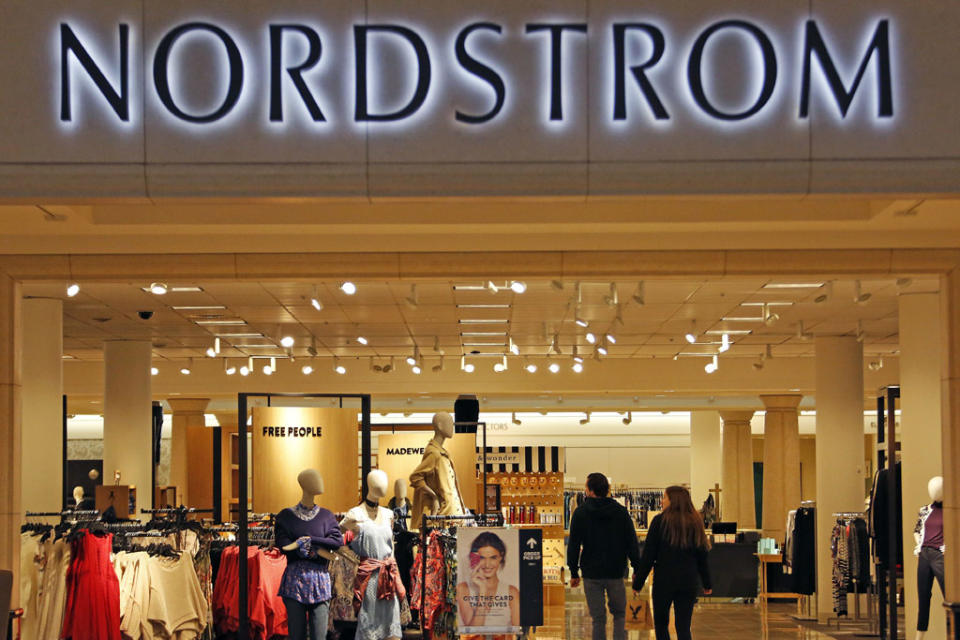Why Nordstrom is beating all of its department store competitors

Calls for the death of brick-and-mortar retail have increased as many major department stores continue to report gloomy sales performance. But one dominant name seems to have separated itself from the pack: Nordstrom (JWN).
“Nordstrom appears to be years ahead of its peers in digital initiatives and development of its off-price concept,” according to Susquehanna’s Bill Dreher. “It is one of the few department stores with clear plans showing results to address unprecedented changes sweeping through the industry.”
The company’s 1.7% same-store sales growth in the second quarter bucked the trend of negative sales from peers like Macy’s (M), Kohl’s (KSS) and JC Penney (JCP).
While the stock is down 6% year-to-date, it’s nevertheless outperforming peers.

These moves up have been driven by results and not just the recent rumors that it might go private, according to analysts. And it’s not about luck, either. The company’s aggressive and early moves into two key growth areas — e-commerce and off-price — are separating it from the pack. Superior execution and customer service have also differentiated the brand.
Nordstrom’s e-commerce dominance
Nordstrom generates 23% of its sales online and management expects that number will exceed 25% by the end of the year. This stands well above other department stores: Macy’s and Kohl’s have 16% online penetration and JC Penney has 14%. Nordstrom’s larger online presence is key for sales growth, according to analysts, especially in the wake of dominance from online behemoth Amazon (AMZN).
Nordstrom didn’t get there overnight. The company was one of the earliest entrants to e-commerce, launching its full-price online shopping site in 1998 and continuing to innovate at a fast clip, according to RBC. It bought flash sale site HauteLook in 2011 for $180 million, marking the first time a traditional retailer acquired a company focused on online private sales. It further gained customers by building partnerships with online-first brands early on, including announcing a 2012 partnership with Bonobos.
“[Nordstrom] currently offers one of the better online experiences in retail with a no-minimum for free shipping policy, as well as additional conveniences including a ‘text to buy’ app, tag and credit card scanning, in-store pick-up, and text notifications,” RBC’s Brian Tunick wrote.
On the second-quarter conference call, Blake Nordstrom, the company’s co-president, highlighted its priority to build on the company’s successful online strategy, including efforts to use e-commerce to encourage more in-store traffic.
Nordstrom’s “Reserve Online & Try in Store” will expand to 50 stores by the end of the year, he said, with 80% of customers who try the service choosing to shop this way again.
“We’ve modernized our platform, enabling us to increase the speed and agility of enhancements to our product pages, navigation and content,” he added.
The company’s online platform has also helped it grow its loyalty presence, now with 9.4 million active rewards members that made up 56% of sales last quarter.
Nordstrom’s off-price advantage
Meanwhile, Nordstrom’s off-price offering, “Nordstrom Rack,” has provided a strategic advantage.
In the second quarter, total off-price sales rose 9.8%, with comparable store sales up 3.1%, an improvement of 100 basis points from last quarter.
The company’s 232 Rack store locations has grown ever since the first location in 1973, with sales aided by its first website in 2014.
Off-price now represents about 30% of the company’s revenue.
Meanwhile, Macy’s off-price concept, “Backstage,” was rolled out just in 2015, making it much later to the lucrative off-price game, where names like TJX (TJX) and Ross Stores (ROST) have continued to soar.
Execution
Beyond core strategic initiatives, Nordstrom’s customer service has set it apart, according to analysts.
“[Nordstrom’s] superior customer service is another factor that positions it more defensively against competition at the mall and online,” Tunick wrote in a recent note. “Nordstrom’s disproportionate emphasis on areas that require a high level of service including beauty and footwear makes Nordstrom a destination for those categories.”
The company has invested in partnerships with trending brands via shop-in-shops, allowing it to bring more excitement to stores with minimal risk, Tunick added. Partnerships include Madewell, TopShop, Warby Parker and Baublebar, which have become important traffic drivers.
Nordstrom has also been able to side-shuffle the excessive discounting environment that has hit profitability at peers.
Its promotional strategy, including its just-completed anniversary sale, offers brand-new arrivals at reduced prices. This contrasts with the mainstream strategy to offer discounts on inventory that doesn’t sell, which has been espoused by peers.
“What really drives our business is newness and regular price flow,” Blake Nordstrom said on the company’s second-quarter conference call. “And even if you looked at an anniversary sale, we did well with anniversary product, but we did particularly well with regular price product and sale too.”
The company’s gross margins have also been aided by the rollout of private-label, which outperformed in the most recent quarter. This is also particularly important, as vendor brands like Michael Kors (KORS), Ralph Lauren (RL) and Coach (COH) have recently made efforts to offer less merchandise at department stores.
“When done right, the proprietary brands can be a real asset for us,” Peter Nordstrom, the company’s co-president, said on its second-quarter conference call. “And we’ve had a lot of good success over the years. So I think it’s nice to have that play itself out.”
Nicole Sinclair is markets correspondent at Yahoo Finance.
Please also see:
How Marriott plans to beat Airbnb in winning over Chinese travelers
Fast food chains are coping with their labor cost problem
Short-sellers have lost $7.1 billion betting against this year’s hottest tech stocks
America doesn’t need to be the world leader to prosper
